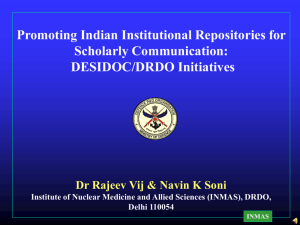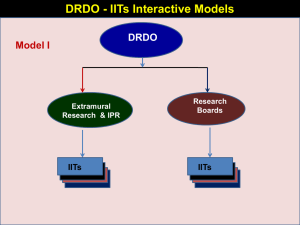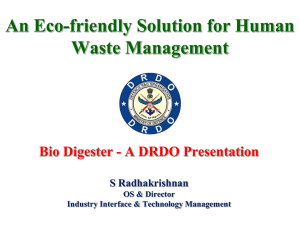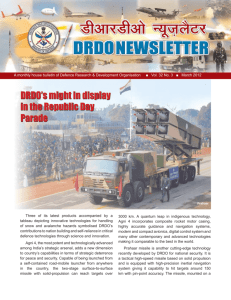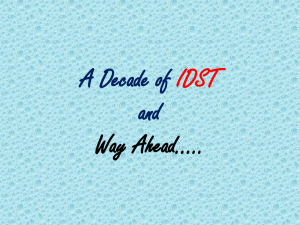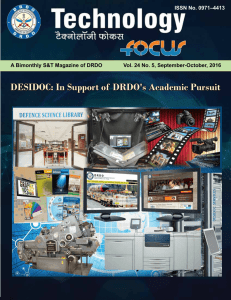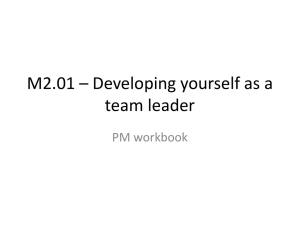PPT
advertisement
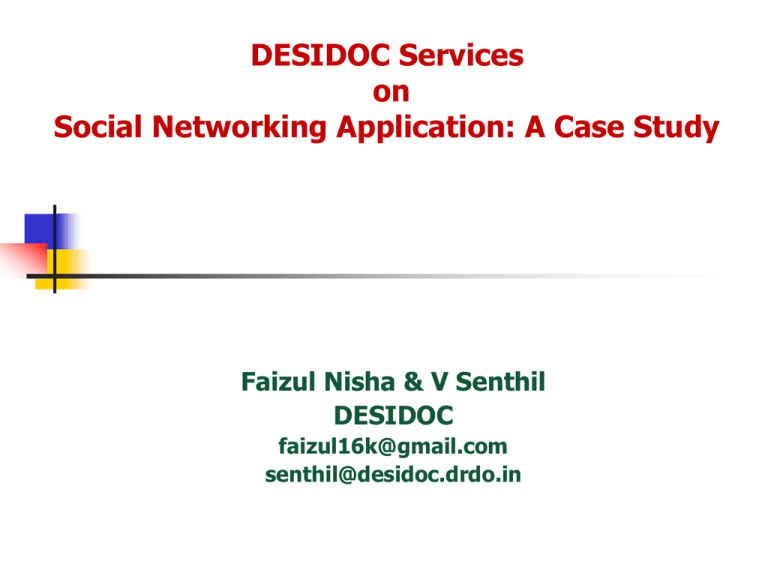
DESIDOC Services on Social Networking Application: A Case Study Faizul Nisha & V Senthil DESIDOC faizul16k@gmail.com senthil@desidoc.drdo.in INTRODUCTION Web 2.0 opening new avenues and giving libraries the ability to offer the improved customer-driven services to the user communities. The terms like blog, wiki, Really Simple Syndication (RSS), E-mail forums, personal web learning, shared videos, video online and podcasting are gaining popularity in the present scenario. DESIDOC is keeping a vigilant eye to provide a platform for the DRDO communities for sharing their valuable knowledge and experiences through DRDO Blog and DRDO Wiki. DESIDOC is helping in managing a great pool of knowledge which is inhabited in the minds of scientists and engineers who are engaged in R&D activities related to Defence Science and Technology and related applications. DRDO SERVICES DRDO Blog DRDO Wiki Institutional Repository DRDO Knowledge Repository Digital Library for DSJ, DJLIT Translation Database Reference Service Website Hosting DRDO BLOG Started by DESIDOC in 2008. To share the knowledge of DRDO scientists/research community to all subject areas and general topic. Supports Unicode, users can directly post the queries in any Indian languages. Software used Word Press 2.0. PHP is front-end MySql is back-end and running on Red Hat Linux server. The archives of posting/comments are maintained Month-wise and Year-wise. RSS Feed also available. How to Post Queries/Comments Open to all DRDO community. User has to register for posting any queries using DRDO Intranet Email. Post the query in any of the subject covered Aeronautics, Armaments, Combat Vehicle, Computers, Electronics, Environment, General, Library & Information Science, Life Sciences, Materials and Naval Research. Post the query in any Indian language covered Hindi, Punjabi, Tamil, Telugu and Kannada. Subject-Wise Postings on DRDO BLOG Sl. No Subject No. of Posts 1 Aeronautics 69 2 Armaments 36 3 Combat Vehicles 31 4 Computers 252 5 Debate 386 6 Electronics 174 7 Environmental Science 201 8 General 576 9 Library & Information 418 10 Life Sciences 224 11 Materials 95 12 Missiles 22 13 Naval Research 16 DRDO Wiki Started in September 2007. Maintained and hosted by DESIDOC. Powered by Media Wiki version 1.01 The software is having back-end of MySql and front-end in PHP. Open to all DRDO employees who have Intranet connection. Any employee of DRDO can edit the wiki. Authentication by IP or Username/Password. Administrator will approve the content. DRDO Wiki's Statistics 126 registered users and 1705 total pages in the database Includes "talk" pages, about DRDO wiki, minimal "stub" pages, redirects, and others that probably don't qualify as content pages. There have been a total of 7341 page views, and 1409 page edits since DRDO wiki was set up. 1.21 average edits per page, and 4.3 views per edit. Wiki is segmented into different subject areas like art and culture, psychology, information technology and engineering, DRDO for you, knowledge and information technology. Different menu options like view page, edit page, post comment etc. Separate links given for the information on current events, recent changes and community portal. DRDO Institutional Repository DRDO Institutional Repository called Gyansrota for archiving of DRDO intellectual output using DSpace Open Source Software in the year 2007. DRDO IR is available on DRDO Intranet. Presently DRDO IR contains four types of main communities DRDO Headquarters Image Gallery Laboratories Women Contains collections of 3745 articles/papers related to Biographies of eminent DRDO scientists, research papers and articles published by DRDO research community in various journals and conferences. IMPLEMENTATION OF DRDO IR The open source D-Space and E-Prints software were evaluated. D-Space has been chosen to set-up IR on Linux platform. The requests have been sent to the research community to upload their research output in IR or send the copy of their published work to DESIDOC. The request was also sent to the Librarian of the each laboratory for collection of data. In receipt of data, DESIDOC uploaded most of the content into IR. After data collection, it was decided to build/upload the content labwise for easy accessing and usage by the common user. So under the DRDO community, sub communities were created by the lab names. The look and feel also has been changed as per DRDO requirement. The latest uploaded contents are displayed on the right side of the home page and browsing facility has been given in the left side of the home page. CONCLUSION In recent times most of the common library users are becoming net savvy and libraries are required to satisfy the user demands at their desktop itself. The users may not visit the library in future, but the library has to visit its users at their door step. To satisfy the user requirements, DESIDOC has to already been taken initiatives to implement web 2.0 technologies so that relevance of its services may be maintained among the DRDO community. DRDO research community understood the current trends and value of the information; they have adopted these technologies for fulfilling their research needs. THANK YOU
